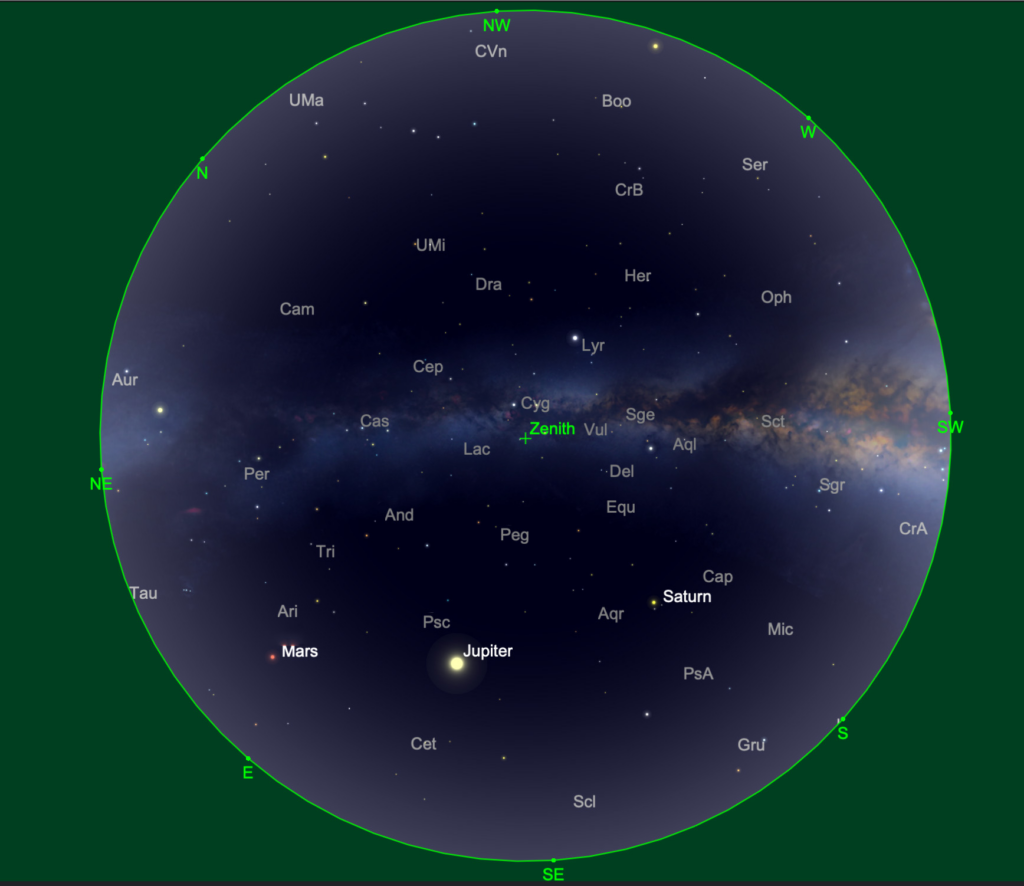Sky Report: July 25-31

The entire sky facing southeast at about 3 a.m. Constellations are identified with their 3-letter designations. Meteors radiate from Aqr and Cap. Graphic created with SkySafariAstronomy.com.
Late-July through mid-August is the best time to watch for meteors, partly because it’s warm at night but mostly because there are two good showers, one long and one short.
First of all, meteors are debris mostly the size of dust to sand, and mostly shed by comets, that encounter the earth and fall through our atmosphere so fast that friction with the air heats them to incandescence and we see them as swift flashes of light. Most burn out many miles above our heads. (Meteorites come from asteroids and they are different; Google can explain.) Meteors fall at random every night of the year at an average rate of about six an hour, but during a meteor shower they can fall at the rate of several dozen an hour. Meteors in a shower come from particles that were recently shed by their comet and are still bunched up, following near that comet’s orbit.
Each shower recurs at the same time each year, when the earth returns to the part of our orbit that is near the comet’s orbit, so they’re easy to predict. The main variable is the moon since its bright light can drown out all but the brightest meteors. Unfortunately that will happen to the second of this period’s showers, August’s Perseids, but not the one this week, the Delta Aquariid, which fall under a dark moonless sky.
Delta Aquariid meteors appear mid-July to mid-August; during the last week of July you should see a dozen or more each hour, radiating from Aquarius low in the south. Unfortunately they’re best between midnight and dawn. They trace their origins to a comet that broke up 9,500 years ago. The Alpha Capricornid meteors peak at the same time and add a few more meteors, some quite bright, to the mix.
At the early morning meteor-watching hour the Milky Way arches from southwest to straight overhead to northeast. The center of the Milky Way is in Sagittarius, low in the southwest, and you can easily see that it is much wider and brighter than the opposite part in the northeast, toward Perseus, which is just rising. Cygnus is straight overhead, and if your sky is dark you can see that the Milky Way is split from Cygnus to the southwest. Dark clouds among the stars that are concentrated here block the light from stars beyond, giving the false impression that it is divided. Even binoculars will show the effect, especially in the little constellation Scutum.
At the same hour Saturn, Jupiter, and Mars (from R to L, or W to E) are arrayed in the south at roughly equal intervals. Jupiter is in the middle and it’s the brightest thing in the sky. Mars and Saturn are brighter than any nearby stars.
Look an hour before sunrise on the morning of the 26th to see the ultra-thin crescent moon only 5% illuminated less than 4° from Venus in one of the year’s finest conjunctions.
Stellar Vista Observatory provides portable telescopes and tripod mounted binocular kits on loan for free to residents and visitors in Kane County. Enhance your enjoyment of the night sky! For details or to request a loan, visit https://stellarvistaobservatory.org/discover-the-night-sky/ or drop in to the Kane County Office of Tourism.
The Sky Report is presented as a public service by the Stellar Vista Observatory, a nonprofit organization based in Kanab, Utah, which provides opportunities for people to observe, appreciate, and comprehend our starry night sky. Additional information is at www.stellarvistaobservatory.org. Send questions and comments to John@StargazingAdventures.org.






Comments are closed.